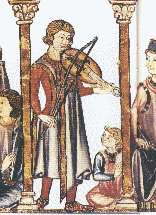Vielle
 | |
| Classification | |
|---|---|
| Related instruments | |
|
Bowed Plucked | |
The vielle /viˈɛl/ is a European bowed stringed instrument used in the Medieval period, similar to a modern violin but with a somewhat longer and deeper body, three to five gut strings, and a leaf-shaped pegbox with frontal tuning pegs, sometimes with a figure-8 shaped body.

In margin of Peterborough Psalter.
Early 14th Century.
The instrument was also known as a fidel or a viuola, although the French name for the instrument, vielle, is generally used. It was one of the most popular instruments of the Medieval period, and was used by troubadours and jongleurs from the 13th through the 15th centuries.
The vielle possibly derived from the lira, a Byzantine bowed instrument closely related to the rebab, an Arab bowed instrument.[1]

Starting in the middle or end of the 15th century, the word vielle was used to refer to the hurdy-gurdy, as a shortened form of its full name of vielle à roue ("vielle with a wheel").[2]
Several modern groups of musicians have formed into bands to play early music (pre-Baroque), and they sometimes include vielles, or modern reproductions, in their ensembles, together with other instruments such as rebecs and saz.
References
- ↑ “fiddle,” Encyclopædia Britannica, from Encyclopædia Britannica Online: http://www.britannica.com/EBchecked/topic/206069/fiddle (retrieved March 06, 2009)
- ↑
 Chisholm, Hugh, ed. (1911). "Vielle". Encyclopædia Britannica (11th ed.). Cambridge University Press.
Chisholm, Hugh, ed. (1911). "Vielle". Encyclopædia Britannica (11th ed.). Cambridge University Press.